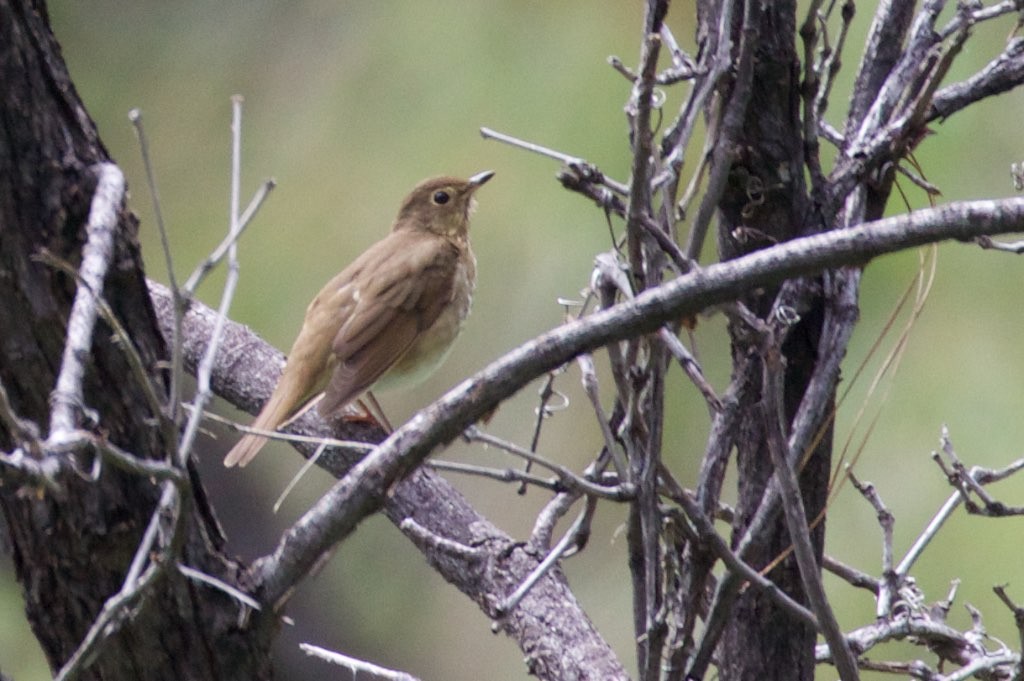Swainson's Thrush
A species of American Brown Thrushes and Nightingale-thrushes Scientific name : Catharus ustulatus Genus : American Brown Thrushes and Nightingale-thrushes
Swainson's Thrush, A species of American Brown Thrushes and Nightingale-thrushes
Botanical name: Catharus ustulatus
Genus: American Brown Thrushes and Nightingale-thrushes
Content
Description People often ask General Info
Description
This species is 16–20 cm (6.3–7.9 in) in length. The wingspan averages at 30 cm (12 in) and the wing chord is 8.7–10.5 cm (3.4–4.1 in). The bill measures 1.5–1.9 cm (0.59–0.75 in) in length and the tarsus is 2.5 to 3.1 cm (0.98 to 1.22 in) long. This species' body mass can range from 23 to 45 g (0.81 to 1.59 oz). This thrush has the white-dark-white underwing pattern characteristic of Catharus thrushes. Adults are brown on the upperparts. The underparts are white with brown on the flanks; the breast is lighter brown with darker spots. They have pink legs and a light brown eye ring. Birds in the east are more olive-brown on the upperparts; western birds are more reddish brown. This bird's song is a hurried series of flute-like tones spiralling upwards. 
Size
16 - 20 cm
Life Expectancy
10 years
Nest Placement
Shrub
Clutch Size
1 - 5 eggs
Number of Broods
10 - 14 days
Nestling Period
10 - 14 days
Feeding Habits
Swainson's Thrush's diet consists of insects and arthropods, such as beetles, caterpillars, flies, grasshoppers, and ants, which is unique among temperate songbirds. During fall and winter, they consume red fruits and berries including elderberries, blackberries, raspberries, and huckleberries, avoiding yellow ones. They forage on the forest floor and in trees, feeding nestlings mostly insects.
Habitat
Swainson's Thrush primarily breeds in coniferous forests, often in streamside woodlands, thickets, and coastal scrub in coastal California. Habitats range up to 8,500 feet elevation but typically below 500 feet in foggy regions. During migration, swainson's Thrush utilizes dense undergrowth across various landscapes. Winter habitats include tropical primary and mature secondary forests.
Nest Behavior
The female swainson's Thrush solely constructs the nest over four days, typically each season. Nesting begins with egg-laying, followed by the female's incubation and both parents contributing to feeding and caring for the young.
Nest Characteristics
Swainson's Thrush's nest is a compact open cup, 1.5-4 inches high, 3.5-6 inches wide with a 2-3.3-inch inner diameter and a depth of 1.0-2.5 inches. Located 3-10 feet off the ground in forest understories, they use twigs, stems, grass, moss, bark, decayed leaves, lined with skeletonized leaves, rootlets, lichens, or moss.
Dite type
Insectivorous
General Info
Feeding Habits
Bird food type
Bird Feeder Type

Platform

Ground
Sounds
Call
Recording location: United States
Call
Recording location: United States
Song
Recording location: United States
Song
Recording location: United States
Behavior
Swainson's Thrush exhibit unique foraging habits, feeding at elevated levels in trees and hopping along branches to glean insects off foliage. They adopt an agile approach to catch prey, including lunging, hovering, and adeptly flycatching. While hunting on the ground, swainson's Thrush employ long, bouncy hops between stops, scrutinizing the leaf litter from a low perch before diving down. These birds communicate through haunting songs, peeping calls, and an array of silent gestures like wing-flitting and leaf-tossing, signaling various behaviors. During migration, swainson's Thrush may integrate into mixed-species flocks for foraging. Their courtship entails aerial pursuits, culminating in shared perching, a testament to their complex social interactions.
